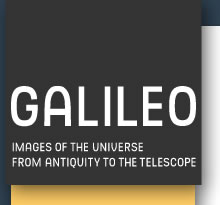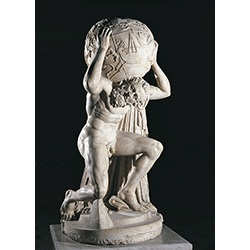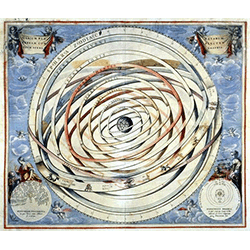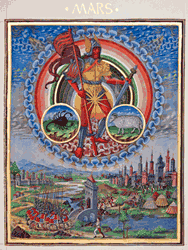


Myths and images of the cosmos
The universe is the place of myths par excellence, a space populated by divinities whose aspect, character and conduct are remarkably similar to those of mankind. While from time immemorial man has seen the planets as personifications of the gods and he has always identified the most visible groups of stars with animals and with familiar or imaginary figures. Of all the numerous cosmic myths of antiquity, the story of Atlas is especially emblematic of the mix of reason and imagination that is so typical of man's interpretation of the universe. After Atlas rebelled against the gods, Jupiter sentenced him to carrying the enormously heavy sphere of the heavens on his back for eternity. The breathtaking Farnese Atlas offers the oldest three-dimensional representation of the heavenly sphere, with its large circles and images of the constellations, to have come down to us.
The image of Atlas carrying the sphere on his back continued to hold astronomers in its thrall in later centuries. Indeed it became a kind of icon for the various techniques used to depict the heavenly vault both on flat surfaces and in three dimensions. The myth was the subject of memorable works of sculpture and painting, and it appeared in fascinating manuscripts, in richly illustrated celestial atlases and on refined astronomical instruments simulating the structure and movements of the universe.

Architectures of the universe
Man has speculated on the shape and structure of the universe since the dawn of history. Descriptions in the oldest texts tell us of a universe in which the earth is flat, with waters above and below it. It was only with the advent of Greek civilisation that the universe took on, in any lasting manner, the form of a sphere that rotates with a regular motion. The stars are strewn on the outer surface, while the planets travel in circular orbits inside the sphere and the earth stands motionless at its centre.
The view of the universe as a sphere was generally accepted for a very long time and is indeed still deeply rooted in common parlance and in people's imagination. But there was a lively debate regarding the orbits of the planets in the celestial sphere and their motion. Numerous world systems were conceived in the centuries separating the classical era from the age of Galileo. Philosophers mooted a variety of solutions in an effort to match the celestial phenomena as closely as possible with their image of the architecture of the universe.

Celestial influxes
Man has always looked to the skies with both dread and expectation. The idea that the stars wield crucial influence over mankind was shared by all ancient civilisations. We might say that the heavens speak to men just as men speak to the heavens.
When interrogated according to the correct procedures, the heavenly vault can reveal an individual's fate, indicate the most propitious days for decisions affecting public and private life, foretell the astral configurations that announce crucial turning points in history, reveal the inclinations and practical aptitudes of an individual's character, show the influence that the planets and the signs of the zodiac have over the organs of the human body, and so on.
The intense and continuous exchange at different levels between man and the cosmos are at the root of astrology, one of the oldest and most pervasive of disciplines. Astrology earned and maintained for a very long time the status of a true science, based on rigorous procedures. Indeed there is even some justification for its having been called the "mother" of astronomy. Without the crucial stimulus of the needs to which astrology seemed to be able to provide answers, our knowledge of the structure and workings of the heavens would never have grown as speedily as history shows it to have done.
